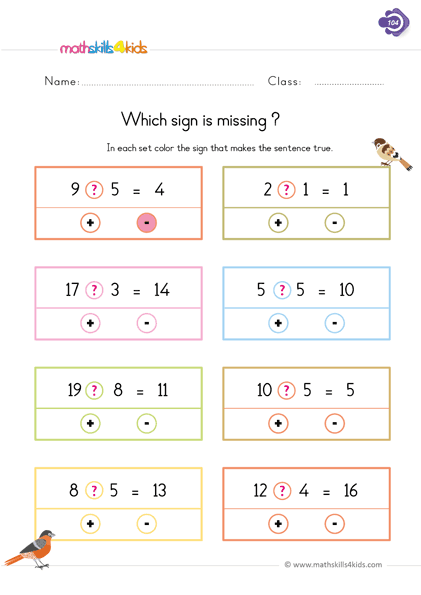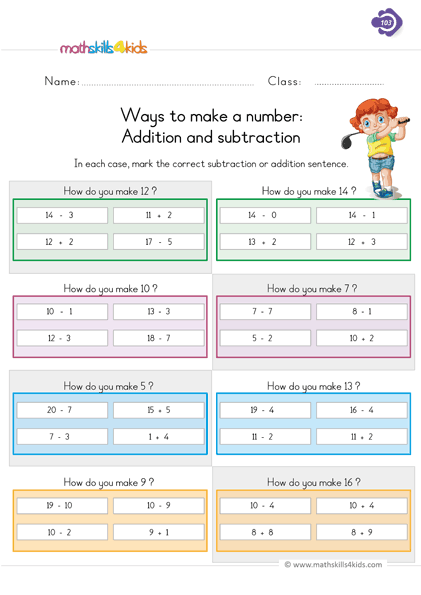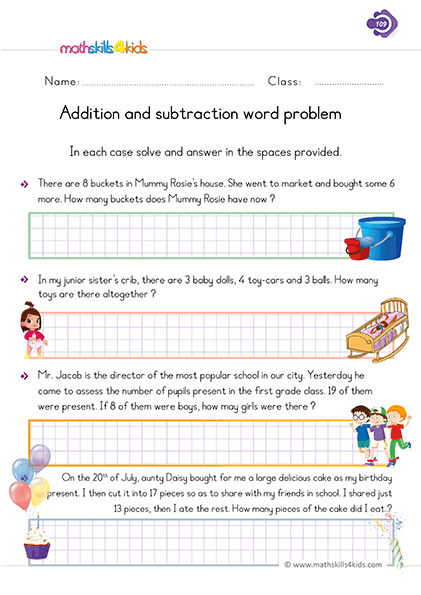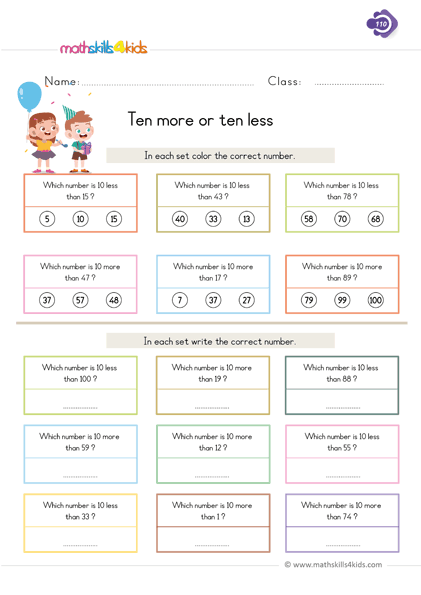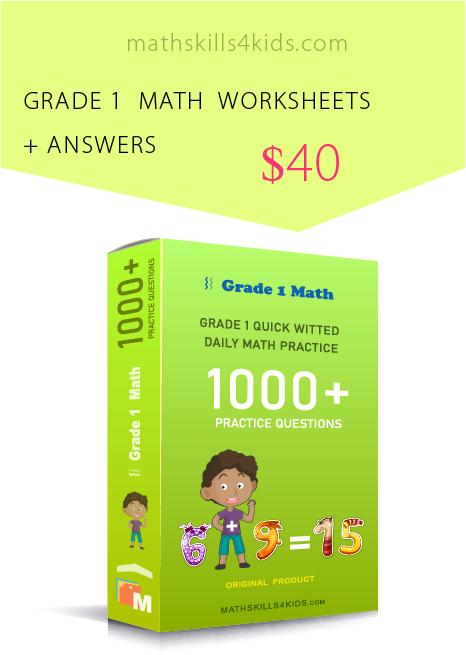Free printable 1st Grade addition and subtraction worksheets
Are you looking for fun and easy ways to help your child learn addition and subtraction in 1st Grade? Do you want to give your child a solid foundation in math skills that will benefit them throughout their academic and professional lives? If so, you've come to the right place!
In this remarkable resource, we will help you know why 1st Grade math skills are so important for your child's future, how to help your child master addition and subtraction in a fun and easy way, and how to access some free printable 1st Grade addition and subtraction worksheets that will make math learning a breeze.
Also, we will give you some tips and tricks to make math learning more engaging and enjoyable for your child and some bonus resources and activities to boost your child's math confidence and skills.
Ready to get started? Let's dive in!
-
Why 1st-Grade math skills are so important for your child's future
Mastering math skills in 1st Grade is about more than passing exams. As you go through this resource, you'll discover that early math skills are essential for your child's future.
Math is everywhere in our daily lives. We use it to measure, count, compare, estimate, plan, budget, solve problems, and more. Math helps us make sense of the world and communicate effectively with others. Math also develops our logical thinking, creativity, and critical thinking skills.
That's why it's crucial to help your child develop a strong foundation in math skills from an early age. Research shows that early math skills are among the best predictors of later academic success and career opportunities. Children with good math skills in 1st Grade tend to perform better in other subjects, such as reading, science, and social studies.
They also have higher self-esteem, motivation, and confidence in their abilities.
One of the most important math skills your child needs to master in 1st Grade is addition and subtraction. Addition and subtraction are the building blocks of arithmetic, which is the basis of all other branches of math.
Addition and subtraction help your child understand the concepts of number sense, place value, patterns, relationships, and operations. They also prepare your child for more advanced topics such as multiplication, division, fractions, decimals, algebra, geometry, and more.
-
BROWSE THE WEBSITE
-
DOWNLOAD FREE WORKSHEETS
-
-
1st GRADE MATH TOPICS
- Counting and numbers
- Understand addition
- Addition skills
- Addition exercises
- Addition strategies
- Understand subtraction
- Subtraction skills
- Subtraction Exercises
- Subtraction strategies
- Mixed operation
- Comparing numbers up to 100
- Estimation Worksheets
- Place value
- Spatial sense
- Graphing & data
- Measurement
- Patterns
- Probability
- Sorting & classifying
- Telling time
- 2D shapes
- 3D shapes - Solids figures
- Fractions
-
-
How to help your child master addition and subtraction in a fun and easy way
The best way to help your child master addition and subtraction is to make it fun and easy. Children learn best when they are engaged, interested, and motivated. They also need plenty of practice and feedback to reinforce their learning.
Here are some tips on how to help your child master addition and subtraction in a fun and easy way:
- Use concrete objects or manipulatives to help your child visualize the concepts of adding and subtracting. For example;
you can use blocks, beads, buttons, coins, or anything else your child can count and move around.
- Use games and activities to make math learning more interactive and enjoyable. For example, you can play card games, board games, dice games, or online games that involve adding and subtracting.
You can also use songs, rhymes, stories, or jokes that involve adding and subtracting.
- Use real-life situations to make math learning more relevant and meaningful. For example, you can use grocery shopping, cooking, baking, or sports to show your child how adding and subtracting are used in everyday life.
You can also ask your child to solve problems involving adding and subtracting using their interests or hobbies.
- Use praise and encouragement to make math learning more positive and rewarding. For example, you can celebrate your child's achievements, point out their progress, acknowledge their efforts, and give them constructive feedback.
- Use concrete objects or manipulatives to help your child visualize the concepts of adding and subtracting. For example;
-
Free printable 1st Grade addition and subtraction worksheets: What you need to know
One of the most effective ways to help your child practice addition and subtraction is to use worksheets. Hence, we have created some free printable 1st Grade addition and subtraction worksheets that will explain all you need to know about addition and subtraction in a fun and easy way.
These worksheets will provide your child with structured exercises covering different adding and subtracting aspects. Also, they will allow your kids to work at their own pace and difficulty level.
Above all, they are easily accessible. You can download and print it right now.
Here's what you need to know about these 1st Grade addition and subtraction worksheets:
- They cover six key topics related to adding and subtracting: ways to make numbers, find the missing sign (plus or minus), addition and subtraction facts, addition and subtraction sentences (true or false), solving real-life problems involving addition and subtraction, and ten more or ten less.
- They include different types of questions, such as filling in the blanks, circling the correct answer, writing the answer, and drawing a picture.
- They have colorful graphics and cute characters, making them more appealing and engaging for your child.
- They have clear instructions and examples to guide your child through each topic and question.
- They have answer keys at the end to help you check your child's work and provide feedback.
Adding and subtracting: Ways to make numbers
The first topic these worksheets cover is ways to make numbers using addition and subtraction. This topic helps your child understand how to compose and decompose numbers using two or more addends or subtrahends.
For example,
5 = 2 + 3 ; 5 = 4 + 1 ; 5 = 3 + 2 ; 5 = 5 + 0 ; 5 = 6 - 1
5 = 7 - 2 ; 5 = 8 - 3 ; 5 = 9 - 4 ; 5 = 10 - 5
These worksheets will help your child practice finding different ways to make numbers up to 20 using addition and subtraction.
Find the missing sign (Plus or Minus)
The second topic these worksheets cover is finding the missing sign (plus or minus) in an equation. This topic helps your child apply their knowledge of addition and subtraction facts to complete an equation with a missing operation.
For example,
6 _ 2 = 4
The missing sign is a minus (-) because 6 - 2 = 4.
These worksheets will help your child practice finding the missing sign (plus or minus) in equations up to 20.
Addition and subtraction facts
The third topic that these worksheets cover is addition and subtraction facts. These are basic equations that your child should memorize to speed up their mental calculations.
For example,
2 + 3 = 5
5 - 3 = 2
These worksheets will help your child practice recalling addition and subtraction facts up to 20.
Addition and subtraction sentences: True or False
The fourth topic that these worksheets cover is addition and subtraction sentences: true or false. This topic helps your child evaluate whether an equation is true or false using their knowledge of addition and subtraction facts.
For example,
6 + 2 = 9
This equation is false because 6 + 2 = 8.
These worksheets will help your child practice identifying addition and subtraction sentences as true or false up to 20.
Solve real-life problems involving addition and subtraction
The fifth topic these worksheets cover is solving real-life problems involving addition and subtraction. This topic helps your child apply their adding and subtracting skills to solve problems related to their everyday life.
For example,
Anna has 7 apples. She gives 3 apples to Ben. How many apples does Anna have left?
This problem can be solved by subtracting:
7 - 3 = ?
Anna has 4 Apples left.
These worksheets will help your child practice solving real-life problems involving addition and subtraction up to 20.
Ten more or ten Less
The sixth topic that these worksheets cover is ten more or ten less. This topic helps your child understand the relationship between numbers that are ten apart using addition or subtraction.
For example,
10 more than 6 is ?
This question can be answered by adding:
6 + 10 = ?
10 more than 6 is ?.
These worksheets will help your child practice finding ten more or ten less than a given number up to 20.
Addition and subtraction terms
The last topic that these worksheets cover is addition and subtraction terms. This topic helps your child learn the vocabulary related to adding and subtracting, such as addend, sum, subtrahend, difference, plus, minus, equal, more than, less than, etc.
These worksheets will help your child practice matching addition and subtraction terms with their definitions or examples.
-
How to use these worksheets effectively with your child at home or in school
These worksheets are elementary to use. All you need is a printer, some paper, and a pencil. You can print as many copies as you need for your child or your class. You can also laminate them or put them in sheet protectors if you want to reuse them. Here are some tips on how to use these worksheets effectively with your child at home or in school:
- Before giving your child a worksheet, review the concepts and skills it covers. For example;
If the worksheet is about adding two-digit numbers, you can remind your child how to line up the numbers, regroup if necessary, and add from right to left.
- Encourage your child to work independently, but be available to offer guidance and support if they need help or make a mistake. Praise their efforts and celebrate their successes.
- Check your child's answers and provide feedback. You can use the answer keys provided at the end of each worksheet.
You can also use a calculator or a number line to help your child check their own work.
- Please discuss with your child how they solved each problem and what strategies they used.
You can ask them questions like: How did you figure out this problem? What did you do first? What did you do next? Why did you choose this method? How do you know your answer is correct?
- Extend your child's learning by asking them to create their own problems or explain their reasoning in words. You can also challenge them to solve the same problem differently or with different numbers.
- Before giving your child a worksheet, review the concepts and skills it covers. For example;
-
Tips and tricks to make math learning more engaging and enjoyable for your child
Math can be fun and exciting for your child if you make it so. Here are some tips and tricks to make math learning more engaging and enjoyable for your child:
- Make math relevant to your child's interests and experiences. For example, if your child likes sports, you can use sports-related examples or scenarios to teach math concepts.
You can use animal-themed worksheets or games to practice math skills if your child likes animals.
- Make math interactive and hands-on. For example, you can use manipulatives such as blocks, coins, counters, dice, cards, etc., to help your child visualize and understand math concepts.
You can also supplement your child's learning with online games, apps, videos, etc.
- Make math creative and fun. For example, you can use art, music, poetry, stories, etc., to teach math concepts or skills.
You can also use jokes, riddles, puzzles, etc., to spark your child's curiosity and interest in math.
- Make math social and collaborative. For example, you can play math games with your child or have them work with a partner or a group on a math project or activity.
You can also encourage your child to share their math work with others or teach someone else what they learned.
- Make math relevant to your child's interests and experiences. For example, if your child likes sports, you can use sports-related examples or scenarios to teach math concepts.
Bonus: More resources and activities to boost your child's math confidence and skills
If you're looking for more ways to help your child improve their math skills, here are some additional resources and activities that can boost your child's math confidence and skills:
- [K5 Learning](https://www.k5learning.com/) - This website offers free worksheets, flashcards, and workbooks for kindergarten to grade 5 kids.
You can also sign up for a free trial of their online learning program, which adapts to your child's level and provides personalized feedback and progress reports.
- [Math Games](https://www.mathgames.com/grade1) - This website offers hundreds of fun and interactive math games for kids in grades pre-K to 8. You can choose games by topic, skill, or grade level.
You can also create your own custom games and track your child's performance.
- [Math Playground](https://www.mathplayground.com/grade_1_games.html) - This website offers a variety of math games, logic puzzles, word problems, videos, and worksheets for kids in grades 1 to 6.
You can also find math manipulatives, such as base ten blocks, fraction bars, number lines, etc.
- [Math Crafts](https://www.weareteachers.com/math-crafts/) - This website offers creative and fun math crafts you can make with your child using simple materials.
You can find crafts for shapes, patterns, fractions, measurements, etc.
- [Math Songs](https://www.youtube.com/playlist?list=PLb7Q5jsm9eh_fdDPQmVpyp4XRu-raUbHc) - This YouTube playlist features some catchy and educational math songs that you can sing along with your child. You can find songs for counting, addition, subtraction, place value, and skip counting.
Thank you for sharing the links of MathSkills4Kids.com with your loved ones. Your choice is greatly appreciated.
We hope you found this resource helpful and informative.
Happy math learning!
-
